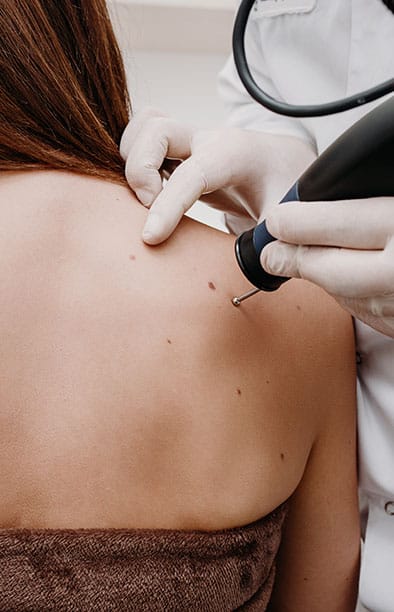What is Mole Removal?
Mole removal is an effective way to completely remove unwanted or suspicious looking moles. Dr. Baird may perform a skin biopsy at the same time to check for any abnormal cells. It’s recommended to be done as soon as possible before the abnormality can spread to other areas. This procedure can be done on any part of the body and remove any type of abnormal mole.
Who is a Candidate for Mole Removal?
Individuals with a concerning mole can benefit from mole removal. Cosmetic mole removal is also a possibility. Dr. Baird can assess your mole and determine the best path forward.
This doctor was great. He let me tell him the whole story of what was going on and was able to tell me exactly what the problem was even though a couple of other doctors had told me something different. He was absolutely right and was very pleasant and personable and I would definitely go back and recommend him to other people seeking a dermatologist. As someone who works at a hospital and works with a lot of doctors, he is one of the greats.”
How to Determine If a Mole Should Be Removed
It is important to keep an eye on all of your moles, as there are signs that a mole could be cancerous. These signs are often called the “ABCDEs” of melanoma skin cancer, and include:
- Asymmetry – one-half of the mole is different from the other half
- Border irregularity – edges of the mole are blurred or ragged
- Color – the color of the mole is not uniform or contains multiple colors
- Diameter – the size of the mole is larger than 6mm
- Evolution – the mole has changed in shape, surface, or color over time
If you are experiencing any of these symptoms in a mole, make an appointment with your dermatologist as soon as possible.
Treatments for Moles
Mole removal can be done using a shave biopsy or excision biopsy. Dr. Baird will recommend the most appropriate option after a thorough examination of your skin. In either case, if the mole is suspected to be cancerous, it will be tested in a lab to be sure that all of the affected tissue has been removed.
Shave Biopsy
A shave excision or shave biopsy uses a scalpel to shave off the mole. There are no stitches required with a shave biopsy. It results in the least amount of scarring, although careful aftercare is needed to ensure against scar formation.
Excision Biopsy
During a surgical excision biopsy, a scalpel is used to cut the border surrounding the mole. The mole is removed, and stitches are placed. On certain areas of the body, such as the face, it can result in noticeable scarring if not properly taken care of.
Before Your Mole Removal Treatment
Dr. Baird will review your detailed medical history ahead of your mole removal procedure. He will carefully examine both the mole and the healthy skin to determine the best approach for surgery. Make sure to arrive at your appointment with clean skin and clothes, without skincare products or makeup. You may need to avoid blood-thinning medications like ibuprofen ahead of your procedure to prevent excess bleeding. Dr. Baird will give you detailed instructions to follow.
Recovery After Mole Removal
Following mole removal, petroleum jelly should be applied to the wound and a bandage should be placed. Treated areas should be cleaned once or twice a day to combat infection. Dr. Baird will supply you with specific post-op instructions to ensure a safe recovery. Scabbing may occur for one to two weeks, and any sutures can be removed one to two weeks following the procedure. It is essential that you keep the area covered with sunscreen once it has healed, as this protects against skin cancer and the reemergence of any abnormal skin cells. Make sure to return for a yearly skin check to look for atypical moles.
Mole Removal in Farmington Hills, MI
If you are experiencing changes in a mole or believe that a mole may be cancerous, contact our Farmington Hills office today. We will get you in for an appointment with Dr. Baird as soon as possible to evaluate your situation.


